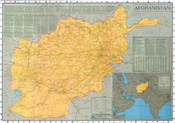 larger 206KB
larger 206KB cartome.org
18 March 2002
Timing is fortuitous
for Afghan mapmaker
Denver Post; Denver, Colo.; Oct 30, 2001
Joy Dickinson Special to The Denver Post;
Copyright Denver Post Oct 30, 2001
ALBUQUERQUE - Abdullah Ayazi left Afghanistan in 1983, escaping Russian-occupied Kabul with an older brother. He's been homesick for 18 years.
So for the past three years, Ayazi has been going home - but only on paper.
Ayazi, an electrical engineer now living in Albuquerque, in 1998 started working on a meticulously researched map of Afghanistan. He had been unable to find a carefully rendered map of Afghanistan, so he decided to make one himself despite a complete lack of experience as a cartographer.
He finished the glossy, full-color map this summer and maxed out his credit cards to print 10,000 copies. Then the maps gathered dust. Ayazi, 38, feared he'd printed a few too many.
That was in August.
Since Sept. 11, however, Ayazi has become the purveyor of an unexpected best-seller. Local stores can't keep the 28-by-40-inch map on the shelves, and one hangs on a wall at the Pentagon.
'The timing was pretty amazing,' said Kathy Bullard, director of map and book sales for Holman's Inc., Albuquerque's best-known map outlet. 'There really wasn't much on the market in the way of maps of Afghanistan, and we didn't know how to fill that void when the demand got so high after Sept. 11.
'We were just thrilled when he came into the store. There's just nothing out there like this map, with this amount of information and detail.'
Ayazi's map features more than 2,500 cities, towns and villages, as well as swamps, oil and gas pipelines, historical shrines and monuments, dirt roads, and military bases. It also sports a historical timeline, cultural tidbits and historical information.
One thing that makes this map unique, Ayazi said, is his attention to changes in the country since the Russian occupation. 'A lot of things are different,' he said.
For example, 'there used to be 28 provinces in Afghanistan - for hundreds of years - but in the last few years, three new provinces have been carved out of existing territory. ... I don't think there's another map out there that has that new information.'
Ayazi's engineering work had given him some drafting experience, but 'that was mostly drawing lines and conduits,' he said. He relied on map-making computer software to help him get the map's technical aspects right.
To ferret out unusual features such as rarely traveled roads, tucked-away pipelines and correct spellings for the names of villages, he consulted several older maps, including satellite images. He also talked with several dozen Afghans who grew up in the various regions, people who 'knew every little feature like the back of their hands.'
'I was very concerned about accuracy,' he said. 'I double- checked, triple-checked everything before going ahead.'
The map took him three years of weekends, often working through the night, for a total of about 3,000 hours.
Even though the map is completed, Ayazi's weekends won't be free for a while, much to the dismay of his wife, Zarghanah, and their three daughters, ages 2, 4 and 6. He's now busy learning Web-page design so he can get his website, www.afghanmap.com, up and running.
Although he expects to sell his map mostly to people curious about Afghanistan, as well as native Afghans now living in the United States, Ayazi also sent copies to the State Department and the Department of Defense.
He received a letter back from the office of the assistant secretary of defense. Harold Heilsnis, director for public inquiry and analysis, wrote that the map has been put 'on display here at the Pentagon.'
'It has heartened the military and civilian personnel who see it and reminded us all once again of the solidarity of the American people in the wake of the attack on our great nation,' he wrote.
Ayazi said he hopes his map has some strategic value in a war he hopes 'can come to a quick resolution, for all our sakes.'
'If I could help them (the U.S. military) win this war against the Taliban, that would be just beyond my wildest dreams.'
Ayazi's map is available
online through his e-mail address: afghanmap@yahoo.com.